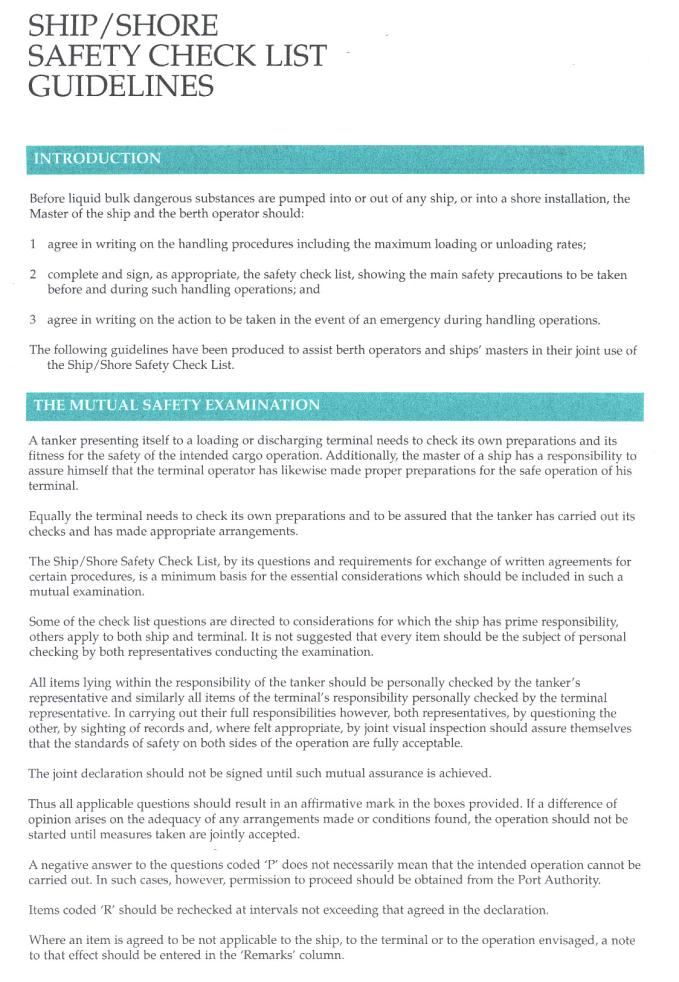c15img036

SHIP/SHORE SAFETY CHECK LIST GUIDELINES
INTRODUCTION
Befare liquid bulk dangerous substances are pumped into or out of any ship, or into a shore installation, the Master of the ship and the berth operator should:
1 agree in writing on the handling procedures including the maximum loading or unloading rates;
2 complete and sign, as appropriate, the safety check list, showing the main safety precautions to be taken before and during such handling opcrations; and
3 agree in writing on the action to be taken in the event of an emergency during handling opcrations.
The following guidelines have been produced to assist berth operators and ships' masters in their joint use of the Ship/Shore Safety Check List.
THE MUTUAL SAFETY EXAMINATION
A tanker presenting itself to a loading or discharging terminal needs to check its own preparations and its fitness for the safety of the intended cargo operation. Additionally, the master of a ship has a responsibility to assure himself that the terminal operator has likewi.se madę proper preparations for the safe operation of his terminal.
Equally the terminal needs to check its own preparations and to be assured that the tanker has carried out its checks and has madę appropriate arrangements.
The Ship/Shore Safety Check List, by its questions and requirements for exchange of written agreements for certain procedures, is a minimum basis for the essential considerations which should be included in such a mutual examination.
Some of the check list questions are directed to considerations for which the ship has prime responsibility, others apply to both ship and terminal. It is not suggested that everv item should be the subject of personal checking by both representatives conducting the examination.
AU items lying within the responsibility of the tanker should be personally checked by the tanker's representative and stmilarly all items of the terminal's responsibility personally checked by the terminal reprcsentatń e. In carrying out their fuli responsibilities however, both representatives, by questioning the other, by sighting of records and, where felt appropriate, by joint visual inspection should assure themselees that the standards of safety on both sides of the operation are fully acceptable.
The joint declaration should not be signed until such mutual assurance is achieved.
Thus all applicable questions should result in an affirmative mark in the boxes provided. If a difference of opinion arises on the adequacy of any arrangements madę or conditions found, the operahon should not be started until measures taken are jointly accepted.
A negative answer to the questions coded T' does not necessarily mean that the intended operation cannot be carried out. In such cases, howeeer, permission to proceed should be obtained from the Port Authority.
Items coded 'R‘ should be rechecked at intervals not exceeding that agreed in the declaration.
Where an item is agreed to be not applicable to the ship, to the terminal or to the operation envisaged, a notę to that effect should be entered in the 'Remarks' column.
Wyszukiwarka
Podobne podstrony:
c15img026 A P P E N DI X This Appendix compriscs the Ship/Shore Safety Check List (Parts A & C),
c15img034 Declaration We the undersigned have checked, where appropuate jointly, the ilems on ihis c
W W? tV^ 1 O? W**UMIEJĘTNOŚCI PIELĘGNIARSKIE KATALOG CHECK-LIST MATERIAŁY ĆWICZENIOWE Z
UMIEJĘTNOŚCI PIELĘGNIARSKIE KATALOG CHECK-LIST MATttlAtT tWICMIIOWf 2 AODSIAW
koliber z motylem i (3) V V • •••Symbol List The pair of colors whose names are listed below in r
ST Z11 16 ST-Z11■ REPLACEMENT PARTS LIST. ..Cabinet & Chassis Parts Notes: 1. Part numbers are i
4 (862) Symbol List The pairs of colors whose names are listed below in red should be combincd in th
List ofeourses. and their Schcmc of evalualion are gis on beloss: First
35508 ST Z11 16 ST-Z11■ REPLACEMENT PARTS LIST. ..Cabinet & Chassis Parts Notes: 1. Part numbers
SZUFLADKI (3) SYMBOL LIST The pnirs of colors wliose names are łisled helów in red should be combine
c15img028 Part A Bulk Liquid General F General Ship Terminal Codę Remarks 1 ls the ship seeurefy
c15img030 General Ship Terminal Codę Remarks 27 Are smoking requirements betng
c15img032 Part C Bulk Liquefied Gases Bulk Liqucfied Gases Ship Terminal Codo Rem.irks 1 Is Infor
RZECZPOSPOLITA POLSKA REPUeUC OF POLANOCERTYFIKAT BEZPIECZEŃSTWA STATKU TOWAROWEGO CARGO SHIP SAFETY
VocabularyTopie vocabulary Jobs & Money
ex3 6 010D JC 119/0110/ -LiOOjf List starting section of program 0100
ex4 15 f>DDT SGWłH&y Rerun debugger to check changes DDT UER 1.0 NEKT PC 0121 0000
więcej podobnych podstron